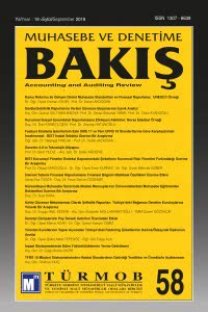IFRS 16 (TFRS 16)’NIN FİNANSAL TABLOLAR VE FİNANSAL ORANLARA ETKİSİ
Uluslararası finansal raporlama standartları, kiralama işlemlerinin muhasebeleştirilmesi, kiralamaların aktifleştirilmesi, finansal oranlar
___
- Accounting Principles Board (1964). Accounting Principles Board Opinion No. 5: Reporting of Leases in Finan-cial Statements of Lessees.
- Altman E. (1976). Capitalization of Leases and the Predictability of Financial Ratios: A Comment. Accounting Review, 51 (2), 408-412
- Barth, M.E., Landsman, W.R. ve Lang M. (2008). International Accounting Standards and Accounting Quality. Journal of Accounting Research, 46, 467–498.
- Beattie, V., Edwards, K. ve Goodacre, A. (1998). The Impact of Constructive Operating Lease Capitalization on Key Accounting Ratios. Accounting and Business Research, 28 (4), 233-254.
- Beattie, V.A., Goodacre, A. ve Thomson, S. (2000). Recognition versus Disclosure: An Investigation of the Impact on Equity Risk Using Operating Lease Disclosure. Journal of Business, Finance and Accounting, 27 (9), 1185- 1224.
- Bennett, B. ve Bradbury, M. (2003). Capitalizing Non-Cancelable Operating Leases. Journal of International Fi-nancial Management and Accounting, 14 (2), 101-114.
- Branswijck, D., Longueville, S., ve Everaert, P. (2011). The Financial Impact of the Proposed Amendments to IAS 17: Evidence from Belgium and The Netherlands. Accounting and Management Information Systems, 10 (2), 275-294.
- Bryan, S.H., Lilien, S. v Martin, D.R. (2010). The Financial Statement Effects of Capitalising Operating Leases: Assessing the Right of Use Model. The CPA Journal, 80(8), 36-41
- Daske, H. (2006). Economic Benefits of Adopting IFRS or US-GAAP - Have the Expected Costs of Equity Capital Really Decreased?. Journal of Business & Finance, 33 (3), 329-37.
- Duke, J. C., ve Hsieh, S.J (2006). Capturing the Benefits of Operating and Synthetic Leases. The Journal Corporate Accounting & Finance, 18 (1), 45-52.
- Duke, J.C., Hsieh, S.J., ve Su, Y. (2009). Operating and Synthetic Leases: Exploiting Financial Benefits in the Post-Enron Era. Advances in Accounting, Incorporating Advances in International Accounting, 25, 28-39
- Elam R. (1975). The Effect of Lease Data on the Predictive Ability of Financial Ratios. The Accountig Review, 50 (1), 25-43.
- Ernst & Young (2016). Lease: A summary of IFRS 16 and Its Effect
- Gritta R. (1974). The Impact of the Capitalization of Leases on Financial Analysis. Financial Analysts Journal, 30 (2), 47-52.
- Hail, L., Leuz, C. ve Wysocki, P. (2010).Global-Accounting Convergence and the Potential of Adoption of IFRS by the U.S. (Part I): Conceptual Underpinnings and Economic Analysis. Accounting Horizons, 24 (3), 335-394.
- International Accounting Standards Board (IASB) (2018). Framework for the Preparation and Presentation of inancial Statements.
- International Accounting Standards Board (2016). International Financial Reporting Standard No. 16: Leases (IFRS 16).
- International Accounting Standards Board (2016).International Accounting Standard No. 17: Leases (IAS 17).
- Imhoff E., Lipe R. ve Wright, D. (1991). Operating Leases: Impact of Constructive Capitalization. Accounting Horizon, 5 (1), 51-63.
- Imhoff E., Lipe R. ve Wright, D. (1997). Operating Lease: Income Effects of Constructive Capitalization. Accoun¬ting Horizon, 11 (2), 12-37.
- Ingberman M., Ronen J. ve Sorter G. (1979).How Lease Capitalization under FASB Statement No:13 ill Affect Financial Ratios. Financial Analyst Journal, 35 (1), 28-31.
- KPMG (2016). IFRS 16 Leases: A more Transparent Balance Sheet.
- Leuz, C. ve Verrecchia, R. E. (2000). The Economic Consequences of Increased Disclosure. Journal of Accounting Research, 38, 91-124.
- Osei E. (2017). FASB and IASB Signs Similar Tune: Comparing the Accounting Treatment of New IFRS 16 with IAS 17, and the New FASB Model on Leas. Journal of Theoretical Accounting Research, 13 (1), 1-22.
- Öztürk M. ve Serçemeli M. (2016).Impact of New Standard “IFRS 16 Leases” on Statement of Financial Position and Key Ratios: A Case Study on an Airline Company in Turkey. Business and Economics Research Journal, 7 (4), 143-157.
- Securities Exchange Commission (2005). Report and Recommendations Pursuant to Section 401 (c) of the Sar-banes-Oxley Act of 2002 on Arrangements with Off-balance Sheet Implications, Special Purpose Entities, and Transparency of Fillings by Issuers”, www.sec.gov/news/studies/soxoffbalancerpt.pdf.
- Shillinglaw G. (1958). Leasing and Financial Statement. The Accounting Review, 33 (4), 581-592.
- Soobrian L. (2017). Financial Impact on Companies by FASB Change in Accounting for Leases. 7th Annual Inter¬national Conference on Accounting and Finance (AF 2017), 7-16.
- Wong K. ve Joshi M. (2015).The Impact of Lease Capitalization on Financial Statement and Key Ratios: Evidence from Australia. Australian Accounting Business & Finance Journal(AABFJ), 9 (3), 27-44.
- ISSN: 1307-6639
- Yayın Aralığı: 3
- Başlangıç: 2000
- Yayıncı: TÜRMOB
Hüseyin ÖZYİĞİT, Sait KAYGUSUZ
KREDİ DERECELENDİRME SÜRECİNDE SÜRDÜRÜLEBİLİRLİK FAKTÖRLERİNİN ÖNEMİ
HALKA ARZIN İŞLETME PERFORMANSINA ETKİSİ: BORSA İSTANBUL ŞİRKETLERİ ÜZERİNE BİR İNCELEME
Recep GÜNEŞ, Fatma AKYÜZ, Müge SAĞLAM BEZGİN
İKLİM DEĞİŞİKLİĞİ MUHASEBESİ ARAŞTIRMALARININ BİBLİYOMETRİK ANALİZİ
Reşat KARCIOĞLU, Seyhan ÖZTÜRK
DENETİMDE GÜÇLÜ BİR ARAÇ “BENFORD YASASI”: KAMU İDARESİ HESAPLARINDA BİR UYGULAMA
Merve KIYMAZ KIVRAKLAR, Reyhan ERSOY CAN
ESG SKORUNUN FİRMAYA ÖZGÜ BELİRLEYİCİLERİ, BORSA İSTANBUL ÖRNEĞİ
KOBİ’LER İÇİN UFRS’DE İKİNCİ KAPSAMLI GÖZDEN GEÇİRME TASLAĞINA GENEL BAKIŞ
LOJİSTİK MALİYETLER VE YEŞİL LOJİSTİK: DIŞSAL MALİYETLERİN ANALİZİ
